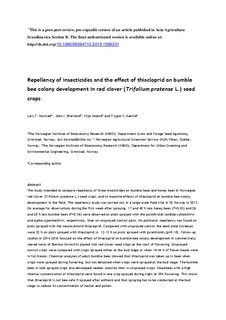| dc.contributor.author | Havstad, Lars T. | |
| dc.contributor.author | Øverland, John Ingar | |
| dc.contributor.author | Valand, Silja | |
| dc.contributor.author | Aamlid, Trygve | |
| dc.date.accessioned | 2019-11-11T12:51:57Z | |
| dc.date.available | 2019-11-11T12:51:57Z | |
| dc.date.created | 2019-06-14T10:51:33Z | |
| dc.date.issued | 2019-03-20 | |
| dc.identifier.citation | Acta Agriculturae Scandinavica - Section B, Soil and Plant Science. 2019, 69 (5), 439-451. | nb_NO |
| dc.identifier.issn | 0906-4710 | |
| dc.identifier.uri | http://hdl.handle.net/11250/2627733 | |
| dc.description.abstract | The study intended to compare repellency of three insecticides on bumble bees and honey bees in Norwegian red clover (Trifolium pratense L.) seed crops, and to examine effects of thiacloprid on bumble bee colony development in the field. The repellency study was carried out in a largescale field trial in SE Norway in 2013. On average for observations during the first week after spraying, 17 and 40% less honey bees (P = .03) and 26 and 20% less bumble bees (P = .36) were observed on plots sprayed with the pyrethroids lambda-cyhalothrin and alpha-cypermethrin, respectively, than on unsprayed control plots. No pollinator repellency was found on plots sprayed with the neonicotinoid thiacloprid. Compared with unsprayed control the seed yield increases were 22% on plots sprayed with thiacloprid vs. 12–13% on plots sprayed with pyrethroids (P = .10). Follow-up studies in 2014–2016 focused on the effect of thiacloprid on bumble bee colony development in commercially reared nests of Bombus terrestris placed into red clover seed crops at the start of flowering. Unsprayed control crops were compared with crops sprayed either at the bud stage or when 18–44% of flower heads were in full bloom. Chemical analyses of adult bumble bees showed that thiacloprid was taken up in bees when crops were sprayed during flowering, but not detected when crops were sprayed at the bud stage. The bumble bees in late-sprayed crops also developed weaker colonies than in unsprayed crops. Dead bees with a high internal concentration of thiacloprid were found in one crop sprayed during the night at 35% flowering. This shows that thiacloprid is not bee-safe if sprayed after anthesis and that spraying has to be conducted at the bud stage to reduce its contamination of nectar and pollen. | nb_NO |
| dc.language.iso | eng | nb_NO |
| dc.subject | Apion spp | nb_NO |
| dc.subject | Bumble bees | nb_NO |
| dc.subject | Honey bees | nb_NO |
| dc.subject | Hypera nigrirostis | nb_NO |
| dc.subject | Pollination | nb_NO |
| dc.subject | Pyrethroids | nb_NO |
| dc.subject | Neonicotinoids | nb_NO |
| dc.subject | Weevils | nb_NO |
| dc.title | Repellency of insecticides and the effect of thiacloprid on bumble bee colony development in red clover (Trifolium pratense L.) seed crops | nb_NO |
| dc.type | Journal article | nb_NO |
| dc.type | Peer reviewed | nb_NO |
| dc.description.version | acceptedVersion | nb_NO |
| dc.subject.nsi | VDP::Landbruks- og Fiskerifag: 900::Landbruksfag: 910::Planteforedling, hagebruk, plantevern, plantepatologi: 911 | nb_NO |
| dc.source.pagenumber | 439-451 | nb_NO |
| dc.source.volume | 69 | nb_NO |
| dc.source.journal | Acta Agriculturae Scandinavica - Section B, Soil and Plant Science | nb_NO |
| dc.source.issue | 5 | nb_NO |
| dc.identifier.doi | 10.1080/09064710.2019.1596301 | |
| dc.identifier.cristin | 1704898 | |
| dc.relation.project | Norges forskningsråd: 225019 | nb_NO |
| cristin.unitcode | 7677,1,0,0 | |
| cristin.unitcode | 7677,4,0,0 | |
| cristin.unitname | Divisjon for matproduksjon og samfunn | |
| cristin.unitname | Divisjon for miljø og naturressurser | |
| cristin.ispublished | true | |
| cristin.fulltext | postprint | |
| cristin.qualitycode | 1 | |
